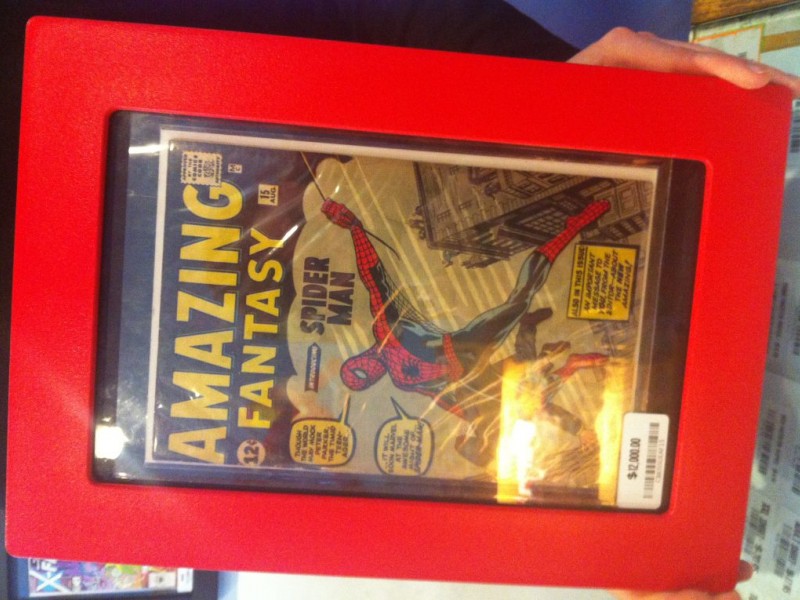Comic book price guides are generally monthly, quarterly, or yearly publications which detail the changes in the resale value of a comic over a period of time. Price guides are also important tools for collectors looking to sell their collection or determine their collection’s worth for insurance purposes.
Each collector will have his or her own preference regarding which authority to follow, but popular and respected guides currently include The Official Overstreet Comic Book Price Guide, Comics Buyer's Guide magazine, Wizard Magazine, the Comics Buyer's Guide Standard Catalog of Comic Books, and Human Computing’s ComicBase, an inventory/databasing software program. Popular online price guides include comicbookrealm.com (free), ComicsPriceGuide.com (free and paid services), nostomania.com (free), RarityGuide (free and paid), and GPAnalysis.com specifically for CGC (certified) Comics (paid). Online and print price guides will have their own discrepancies, so a combination of several sources is often used by collectors to arrive at an accurate estimated value.
Although many price guides come and go, long-standing publications such as Overstreet (which has been running for over 35 years) or the more recent Standard Catalog of Comic Books, have long since become inextricable elements of comic collection history. These guides are popular resources for collectors and enthusiasts seeking information on anything from storylines to writers and artists to the original cover price of a comic. Grand Comics Database and comicbookrealm.com, in particular, offer users the ability to quickly search for characters by appearances and deaths. The Big Comic Book DataBase combines a searchable database of per issue character and creator information and a linked price guide.
The advent of certification enabled increased liquidity of comic books by removing disputes over grading and by disclosing restoration, and accelerated sales of comic books through online auction sites such as eBay or Heritage Auction Galleries. Certification was also a boon to comic price guide providers, as certification removes the uncertainty about the actual grade of the comic book being sold. Individual and/or aggregated reports of certified comic book sales are available online.
History

Beginning in the early 1960s comics collectors (who often traded and sold to each other) were on the rise, and the number of comics dealers began to increase as well. In 1965, Michael Cohen and Tom Horsky published what is considered the first comics price guide, the one-shot digest The Argosy Price Guide (specifically for Hollywood, California's, Argosy Book Shop).
Comic back-issue prices had stabilized by the end of the 1960s. In 1970, Jerry Bails, who had recently published the Collector’s Guide to the First Heroic Age, was considering creating a comic book price guide. He was contacted by Bob Overstreet, who was doing the same thing. Bails' extensive notes, supplemented by Overstreet's study of dealer listings, "became a backbone to the Overstreet Comic Book Price Guide." Overstreet's guide instantly became an invaluable resource tool for comic book collectors.
The Overstreet guide excluded the entire category of underground comix from its listings. This void was first addressed by Jay Kennedy in 1982 with The Official Underground And Newave Comix Price Guide, and while out of print is a valuable resource for information about the artists and publishers. In 2006, Overstreet advisor and contributor Dan Fogel's Hippy Comix, Inc. published Fogel's Underground Comix Price Guide, with 2010 to see a supplement magazine adding minicomics and British undergrounds alongside the latest pricing data.
With the advent of online auctioning services like eBay, price guides have seen dramatic declines in sales because their price listings were not reflective of the actual sale prices of comics. Shortly thereafter, Comics Buyer's Guide magazine and the CBG Standard Catalog of Comic Books started reporting actual completed auction results from eBay, covering periods longer than eBay's results are online. The 2005 edition of the Standard Catalog is 1,624 pages long and reports results back to 2002. The current online price guide for slabbed comics is GPAnalysis, which collects data of actual verified sales from several pre-approved sellers and auction houses.
An established independent company, such as Comic Guaranty LLC (CGC) or Comic Book Certification Service (CBCS) provides third party grading services for comics. Comic books can be sent to these companies for independent, impartial certification, including grading, restoration check and encapsulation within a tamper-evident protective holder.
Comic book grading scale

Dealers and graders may often disagree with some grading classifications. Grading of comics is very subjective. Some grading companies have devised a numeric scale grading system that ranges from 0.5 (poor) to 10.0 (mint). However, most companies use a terminology based grading system that ranges from "Poor" to "Mint". The advantages of a terminology based system is it allows for variation in each grade and even grade overlaps. For example, you can now have a grade called VERY GOOD/FINE. Since grading is very subjective, a third party grading company should be used to authenticate valuable comics.
Terminology

- Title is the name of a comic book series. For example, Action Comics is a title. Within this title, there have been over 900 issues.
- Issue is a single installment of a title, usually with its own number. Examples are Action Comics #23 or The Amazing Spider-Man #42. A volume number may also be included, such as Punisher Vol. 1 #23.
- Grading is the term used to indicate the process of evaluating the condition and consequent value of a comic book. A detailed explanation of how to determine a comic book’s condition based on the established grades is generally included in a comic book pricing guide. A copy that falls between grades may be noted with a or a symbol. These terms are as follows:
Notable price guides

Printed guides
- The Official Overstreet Comic Book Price Guide
- Comics Buyer's Guide
- Comics Values Monthly (Defunct)
- Standard Catalog of Comic Books
- Wizard: The Guide to Comics (Defunct)
- British Comics, Story Papers, Picture Libraries, Girls Papers, American Reprints, Facsmilies, Giveaways Price Guide (1982)
Online guides
- ComicBase
- ComicBookRealm.com
- ComicsPriceGuide.com
- Nostomania
- GPAnalysis â€" specifically for CGC (certified) comics
- GoCollect - Comic Book Price Guide â€" CGC & CBCS (certified) comics & open market research
- RarityGuide.com - Online Price Guides
- SellMyComicBooks.com Historical highs and minimum values
- Comic Book Price Guide - formerly (in print) The Comic Book Price Guide for Great Britain
- Comicsvalue.com - includes English, German and French comics
See also

- Direct market
- Comic book collecting
References

